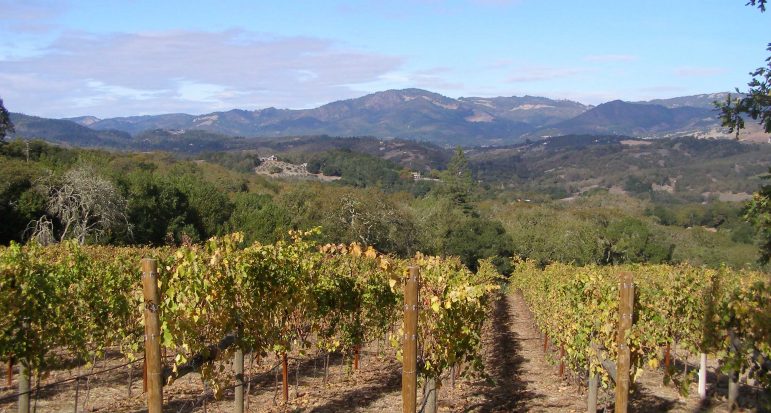
Wildfires have engulfed vineyards in California’s Wine Country. Image: Wikimedia Commons
By Carl Stoddard
Capital News Service
The full impact of wildfires in Northern California’s wine country is not yet clear.
But even if the devastation is severe, Michigan wine producers say it could be a few years before they see any effect, if at all.
Michigan is among the top 10 wine-producing states in the country. Wine sales and grape plantings have been steadily growing for years, said Karel Bush, executive director of the Michigan Grape and Wine Industry Council in Lansing.
What happened in California “really isn’t going to have an impact on Michigan wineries,” Bush said. Most Michigan wineries use grapes grown in their own vineyards or elsewhere in the state.
Michigan has 132 wineries and 3,050 acres planted with grapes for wine, she said. “That number has increased for the last 25 years. It increases every year.”
Michigan, especially areas within 25 or so miles of Lake Michigan, offers an ideal climate for grapes, she said. That’s why wineries keep popping up on that side of the state.
The growing number of wineries isn’t a boon just to Michigan’s agricultural economy, but also to the state’s tourism industry as millions of visitors flock to wineries and wine-tasting rooms, Bush said.
“We have all this water, all this scenery,” she said. That makes Michigan’s vineyards “a great place for tourism.”
Eddie O’Keefe, president of the Chateau Grand Traverse vineyard on Old Mission Peninsula north of Traverse City, said the devastation in California “raises a lot of awareness, but it doesn’t directly affect us. I wouldn’t say we are competing on a head-to-head basis.”
Bad weather in northern Michigan hurt grape production in 2014 and 2015, O’Keefe said. But since then, business has been rebounding, he said.
“Sales seem to be very strong, across the board,” said O’Keefe, whose family-owned business has been making wine since 1974.
The family owns about 120 acres of vineyards and buys grapes from another 100 acres, all on the peninsula.
On average, the winery produces 25 to 30 different wines, which are distributed throughout the Midwest and East Coast, he said.
Chateau Grand Traverse also operates an inn and a wine-tasting room.
“Every Saturday in October is absolutely the busiest time of the year,” O’Keefe said.
Laurie Stabile, owner of the Mackinaw Trail Winery in Petoskey, said if grapevines in California were destroyed in the fires, it could take growers there three to five years to replant, grow and harvest the grapes and get wine back on the shelves.
But because most Michigan wineries grow their own grapes, the impact of the California fires on Michigan’s wine business will be minimal, Stabile said.
Stabile said her business will continue to expand.
“We’re growing, we’ve been growing all along. You can’t make money if you’re not growing,” she said.
Mackinaw Trail Winery grows grapes on about 70 acres, she said. In addition to its winery, it has five tasting rooms, a cider-making facility, a brewery and an event center.
The Legislature established the 11-member Michigan Grape and Wine Industry Council w to promote Michigan’s wine and wine grape-growing industries. The council’s website says new Michigan wineries are starting up every year, wine grape acreage continues to grow and sales of Michigan wines are increasing.
California is the top wine-producing state in the country, making about 90 percent of U.S. wine, according to the National Association of American Wineries in Washington, D.C..
The other top 10 wine-producing states, in order, are Washington, New York, Pennsylvania, Oregon, Vermont, Ohio, Michigan, Kentucky and Texas.
The rankings are based on 2014 figures, the latest available, the wine association said.
California has about 1,200 wineries in Mendocino, Napa and Sonoma counties, the regions most heavily affected by the wildfires, but fewer than 10 have been destroyed or heavily damaged, said the Wine Institute, which represents wineries and related businesses in California.
The three counties represent about 12 percent of California’s wine grape production, the institute said.